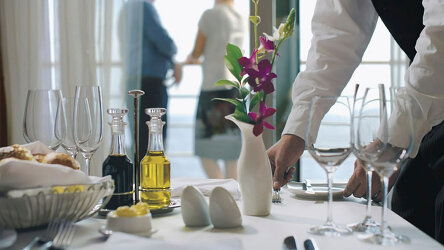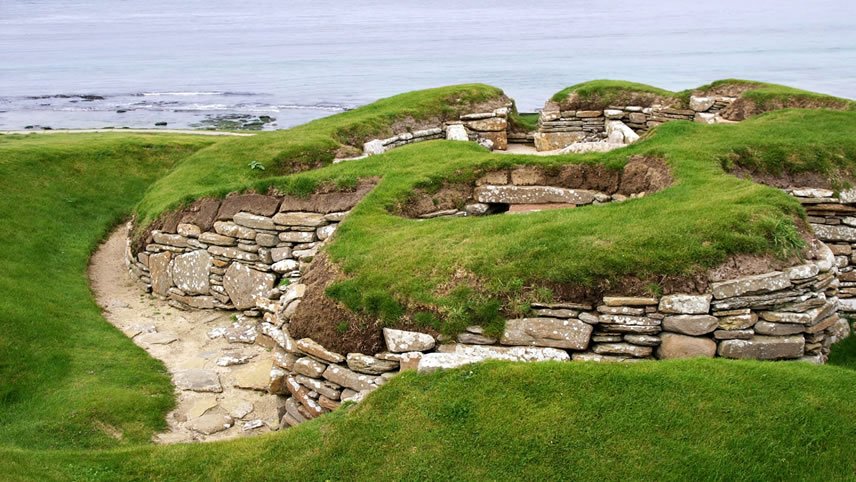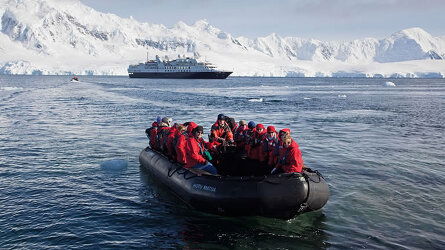Overview
Cruise Itinerary
Start your exploration of Dublin with a visit to Trinity College, home to the ancient Book of Kells. A stroll through the cobbled streets of Temple Bar reveals an array of lively pubs, quirky shops, and the fascinating Irish Film Institute.
History enthusiasts will appreciate the solemn beauty of Dublin Castle and the poignant exhibits at Kilmainham Gaol. For a taste of local flavor, visit the Guinness Storehouse to learn about Ireland's famous stout. End your day with a leisurely walk along the River Liffey, enjoying views of the Ha'penny Bridge and the city's charming Georgian architecture.
Northern Ireland's capital, Belfast, enjoys a wonderful setting of high hills, sea lough and river valley. Reborn as a cool, modern city, it has successfully left its troubles behind, emerging as a hotbed of culture and architecture, where the comfort of a cosy pub is never far away. Ships will dock in Belfast Harbour.
Top Things to Do in Belfast:
- visit the Titanic Belfast Museum
- see the basalt columns of Giant's Causeway
- explore the Hillsborough Castle and Gardens
- take a famous Black Taxi Tour
- travel along Ards Peninsula to Grey Abbey
Spirits are always high on Islay, famously known as ‘The Whisky Island’ thanks to its distinguished collection of heritage-rich distilleries. World-renowned for its exceptional whiskies, Islay - the southernmost of the Inner Hebrides - forms one of Scotland’s historically protected and distinct whisky regions and is the perfect place to savour the unique flavours and nuanced tasting notes of a drink that is emblematic of Scotland. As you arrive in Port Ellen, a charming village nestled around Leodamais Bay, you’ll be waved ashore by Frederick Crescent - a picturesque row of whitewashed houses lining the beachfront. The island’s iconic distilleries, often painted gleaming white with bold signage, invite you to indulge in the typically peaty delights of this flavourful destination. Swirl your glass and admire the prized drams glowing beautifully in the light, before savouring smoky flavours and subtle hints of salty sea air.
Don’t worry if whisky isn’t your tipple, Islay’s rugged shores are perfect for walking - though admittedly you may find yourself wandering between coastal distilleries. Landmarks like the uniquely boxy Carraig Fhada Lighthouse provide charming focal points, while the dramatic cliffs of the Oa Peninsula reveal the American Monument at the Mull of Oa, a poignant tribute to those lost in the sinking of the SS Tuscania during World War I. With its crystal-clear waters, playful seals, and breathtaking windswept scenery, Islay and Port Ellen’s charms linger long on the palate and in the heart.
Known as the 'cradle of Christianity', Iona has an atmosphere of peace and tranquillity, enhanced by green fields and sandy beaches fringed with intense blue-green seas that look more Mediterranean than Scottish.
The island's main attraction is its medieval abbey, established by Saint Columba when he arrived from Ireland in 563. The abbey is a fine example of ecclesiastical architecture dating from the Middle Ages and it also serves as an important site of spiritual pilgrimage. Many kings of Scotland, including the legendary Macbeth, are buried in the nearby cemetery.
The stunning Isle of Lunga is the largest island in the Treshnish archipelago. With volcanic origin the isle was populated until the 19th Century, and remains of black houses can be seen around this magnificent coastal jewel. Abundant plant life and exotic birdlife are now the main inhabitants of the area. Fortunate visitors view the magnificent array of birds, especially the great puffins that breed on the islands plateau. One can sit within just a few feet away without disturbing the avian ambassador’s peace. The 81 hectare island is home to many rare and endangered plants such as, primroses and orchids. Views over the landscape and across the ocean can be seen from the 300 foot high cliffs.
Gloriously remote, the archipelago of St. Kilda towers out of the storm tossed waters of the Atlantic Ocean. The islands are the UK's only dual UNESCO World Heritage Site. They have some of the highest cliffs in Europe, which have large colonies of rare and endangered species of birds, especially puffins and gannets.
Uninhabited since 1930, the islands bear the evidence of more than 2,000 years of human occupation in the extreme conditions prevalent to the area. Human vestiges include built structures and field systems, the cleits and the traditional Highland stone houses.
Boreray Island, part of Scotland's remote St Kilda archipelago, stands as a sentinel in the Atlantic, its sheer cliffs rising dramatically from the sea.
This uninhabited island, known for its rugged landscapes and significant bird populations, is a sanctuary for myriad seabird species, including the northern gannet and puffins, which nest on its steep cliffs.
Boreray's archaeological importance is highlighted by ancient stone structures and cleitean, small stone storage huts used by St Kilda's former inhabitants.
Journey back in time and encounter the overwhelming power of the natural elements as you cruise by one of the most isolated parts of the British Isles.
The Shiant Islands of Scotland, located in the Minch between the Isle of Lewis and the mainland, are a secluded cluster of rugged isles famed for their dramatic cliffs and abundant birdlife. This uninhabited archipelago is an important breeding ground for seabirds, including puffins, razorbills, and guillemots, making it a paradise for birdwatchers and nature enthusiasts.
Visitors are greeted by the raw beauty of steep rock faces and grassy slopes, with the islands' geology providing a fascinating insight into volcanic activity from millions of years ago. Accessible only by boat, the Shiant Islands offer a serene escape into the wild, untouched nature of Scotland's coastal wonders.
Loch Ewe, situated on the northwest coast of Scotland, is renowned for its scenic beauty and historical significance. This sea loch, surrounded by rugged hills and charming villages, offers breathtaking views and tranquil waters. The area played a crucial role during World War II as a gathering point for Arctic convoys, adding a rich historical dimension to its natural allure.
Visitors can explore Inverewe Garden, a stunning botanical garden featuring exotic plants from around the world, thanks to the region's mild climate. The loch is also a haven for wildlife enthusiasts, with opportunities to spot seals, otters, and a variety of bird species. Loch Ewe's blend of history, nature, and serene landscapes makes it a captivating destination in the Scottish Highlands.
Zipping along by Zodiac is the perfect way to discover The Summer Isles, a spectacular archipelago scattered off Scotland’s northwest coast. Island hop across a cluster of around 20 isles and outcrops that wait just a few miles from the Coigach peninsula. Rising from picturesque waters, emerald-green and golden shores reveal jagged cliffs, hidden coves, and sandy beaches. The largest of the islands, Tanera Mòr, is a former hub of the herring industry and remnants of its past remain, including an old post office and deserted cottages.
The surrounding waters are enjoyed by marine life like seals, dolphins, and porpoises - look out for the seals sprawling across the rocks or playfully inspecting approaching boats. Otters slip in and out of the waters, while gannets duck and dive overhead with distant views of the Hebridean islands. During the summer months, you might witness visitors like minke whales or basking sharks gliding by. Bring your binoculars for the birdlife of locations like Priest Island - the Summer Islands host several colonies of puffins, guillemots, and razorbills. Nearby, Achiltibuie village is the gateway to the archipelago, with its crofting community, luxurious Summer Isles Hotel - renowned for serving up award-winning cuisine. The innovative hydroponicum garden thrives in the mild Atlantic climate, producing exotic fruits and vegetables.
Stark Torridonian sandstone cliffs soar up from the Atlantic waves of Handa Island - a scenic island that offers rich rewards for birdwatchers. This remote, wild and windswept island is the perfect sanctuary for hundreds of thousands of seabirds. Located in The Minch, off the west coast of Sutherland in north-west Scotland, the natural escape is protected by the Scottish Wildlife Trust and forms an untouched nature reserve of thriving seabirds. One of the most important seabird breeding sites in north-western Europe, you can see hundreds of pairs of playful puffins burrowing into the terraced cliffs to the north of the island. These delightful birds are just one of the island’s many bird species that swoop in to breed each season. Look closely at the ledged and dramatic cliffs, they are just as alive with activity as the skies above.
Enjoy the soundtrack of squawks, chirps and chatter from the dozens of different resident species. You’ll encounter guillemots, razorbills, great skua and kittiwakes as you crunch along the scenic paths and boardwalks that loop around the island. Look down into the waters too, you might be lucky enough to spot seals, dolphins, and perhaps even basking sharks or orcas in the clear waters below. In contrast to the steep cliffs, Handa Island also features beautiful sandy beaches, with shallow, shimmering turquoise waters on sunny days. The island’s storied sea stacks are also towering landmarks - the most famous being the precarious Great Stack, which rises a staggering 115 metres.
Lerwick, the capital of the Shetland Island Archipelago, offers stone age ruins, heather-covered moors and rugged Scottish highlands. With its dramatic cliffs, Grand Victorian houses, charming Shetland ponies, and Nordic heritage Lerwick allows for hours of entertainment. Smaller ships will dock at the Port of Lerwick, while larger ships will anchor offshore.
Top Things to Do in Lerwick:
- explore the ruins of Scalloway Castle
- hike on Mousa Island
- visit the Shetland Museum
- admire Fort Charlotte
Kirkwall is the capital of the Orkney Islands, it is considered one of the most charming and well preserved small towns in Scotland. The islands offer dramatic landscapes with cliffs rearing 1,000 feet above the waves to sweeping white sand beaches. Small ships will dock at this port, while larger ships will anchor offshore.
Top Things to Do in Kirkwall:
- explore Skara Brae, a Neolithic village
- admire the St. Magnus Cathedral
- visit the Ring of Brodgar
- ponder the Standing Stones of Stenness
- stroll the Viking Capital Walking Trail
Days at sea are the perfect opportunity to relax, unwind and catch up with what you’ve been meaning to do. So whether that is going to the gym, visiting the spa, whale watching, catching up on your reading or simply topping up your tan, these blue sea days are the perfect balance to busy days spent exploring shore side.
The remote fishing villlage of St Abbs is located on the southeast coast of Scotland. It has a rugged setting with jagged cliffs surrounding the town and old fishermen's cottages tumbling down the surf battered harbour. Sea angling, sub-aqua diving, bird-watching and regular sightseeing boat trips run from the harbour.
It is also home to the St Abb's Head National Nature Reserve which has 200 acres of wild and rugged coastline with sheer, seabird-nesting cliffs rising 300ft above the water. From the top of these you'll get a spectacular view of the rugged Berwickshire coast.
Located off the east coast of Scotland, the Isle of May is a wildlife haven renowned for its bustling seabird colonies and rich marine life. A short ferry ride from Anstruther, this small island offers visitors a unique glimpse into the lives of puffins, razorbills, and seals. The island’s rugged landscape is dotted with historic sites, including the remains of a medieval monastery and the Isle of May Lighthouse, Scotland’s oldest operational lighthouse.
Nestled between the Highlands and the Border Hills, Edinburgh is a gracious city noted for its superb skyline, its impressive collection of architecture and its beautiful parks. Here you'll find the best of central eastern Scotland: spectacular views, rolling hills and castles. Ships will dock at the Port of Leith Cruise Liner Terminal.
Top Things to Do in Edinburgh:
- explore the Edinburgh Castle
- visit the Holyroodhouse
- wander down the Royal Mile
- play a round at the worlds oldest golf course
Life Onboard Silver Endeavour

Relax in luxury as you discover the furthest corners of the world aboard Silver Endeavour. Read more

Suites aboard the Silver Endeavour are among the most spacious in the luxury cruise industry. Read more

Uncover hidden gems and visit remote locations alongside experts on a zodiac excursion. Read more

Whether your suitcase needs unpacking, or you need a scented bath drawn, white gloved butler service has you covered. Read more

Discuss the day's exploits with a refreshment and live entertainment in this exquisite venue. Read more

Stay active in the onboard fitness centre, or perhaps indulge in one of the Otium Spa's therapeutic treatments. Read more
Brochure

Silversea Expeditions (2026-27)
Availability
 USD
Port charges, taxes and fees included.
USD
Port charges, taxes and fees included.
Tour & cruises prices are per person. Prices shown have savings applied, are subject to availability and may be withdrawn at any time without notice. Pricing and trip details are correct at this point in time, however are subject to confirmation at the time of booking and are subject to change by Silversea. For cruise itineraries, cabin images are sourced from Silversea. These should be treated as indicative only. Cabin inclusions, upholsteries and room layout may differ to the image(s) shown depending on the ship selected and your sailing dates.



















